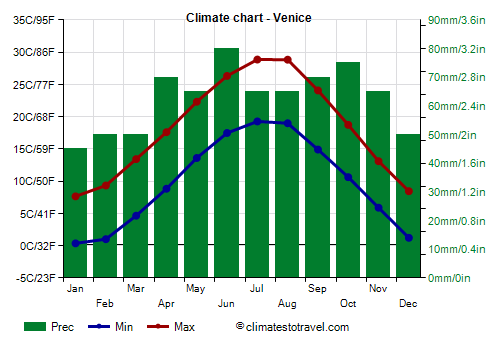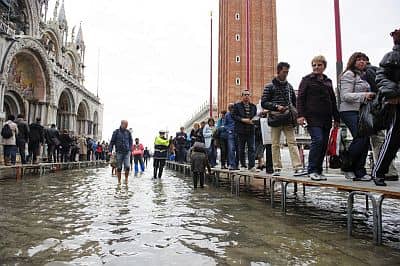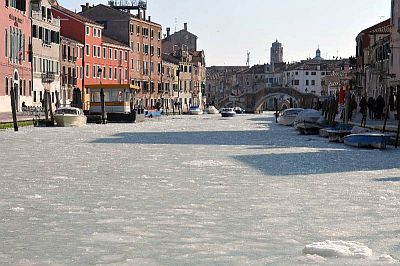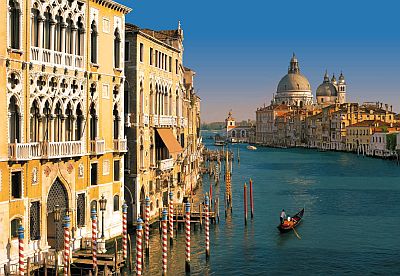Select units of measurement for the temperature and rainfall tables (metric or imperial).
Average weather, temperature, rainfall, sunshine hours

The climate of Venice, the capital of the Veneto region, is
moderately continental, similar to that of the Po Valley, with cold, moist winters and hot, muggy summers, but it's slightly tempered by the Adriatic Sea.
The
average temperature of the coldest month (January) is of 4 °C (39 °F), that of the warmest months (July, August) is of 24 °C (75 °F).
Precipitation totals to 750 millimeters (29.5 inches) per year and is well distributed over the seasons. There are two relative maxima in spring and autumn, when Atlantic depressions are more frequent; in these cases, the south-east wind ("scirocco") blows, which collects moisture over the Adriatic Sea.
In addition to the sirocco, Venice is subject to the
bora, a cold wind blowing from the plains of Eastern Europe, especially in winter and spring. The bora sweeps the Venetian plain and the lagoon of Venice, although with a lower force than in Slovenia and in Trieste, where it is channeled through the mountains.
The phenomenon of the so-called
acqua alta (high water) occurs in bad weather conditions, and it's due to a combination of wind (the sirocco, which obstructs the flow of rivers into the sea) and tide (which raises sea level).
In November 2020, the
Mose, the system of mobile dams that should protect the city from the highest tides, went into operation.
 Winter
Winter, from December to February, is cold, damp and gray. The coldest months are, as is normal in the Po-Venetian plain, January and December. At night, light frosts occur often enough.
Typically, by the second half of February, the temperature tends to increase, and highs reach or exceed quite often 10 °C (50 °F).
Fog is quite frequent, until March.
When the bora blows, the air feels colder than it actually is because of the wind chill.
During the most intense
cold waves, the temperature can drop below -5 °C (23 °F). At Tessera airport, the cold record, -13.5 °C (7.5 °F), was set in January 1963. Other very low values were -12 °C (10.5 °F) in January 1968 and January 1985, -9 °C (16 °F) in January 1987, February 1991 and December 1996, -11 °C (12 °F) in December 2009, and -9 °C (16 °F) in February 2012.
Sometimes, frost can also occur in early March or in late November. During the coldest winters, the lagoon can freeze, as happened in 1929, 1956, 1963, 1985, and in February 2012.
 Snow
Snow in Venice is seen almost every year, but is almost never abundant, in fact, the bora is originally a dry wind, and generally brings at most light snowfalls, while when it snows in the western Po Valley (see Milan), here, the sirocco raises the temperature and brings rainfall.
On average, less than 5 cm (2 in) of snow fall per year. Venice is therefore one of the least snowy cities in northern Italy.
Spring, from March to May, is a quite rainy and unstable season. There is a moderate amount of sunny days, but there can still be cold and foggy days (especially in March) as well as periods of bad weather and wind. Typically, by the second half of April, the temperature becomes pleasant in a more stable manner, but the bora can sometimes still blow, lowering the temperature for a few days, also in May.
Summer, from June to August, is usually sunny, and it's often also hot and muggy, though the breeze tempers a little the heat. In the afternoon, thunderstorms can break out, while the bora can sometimes blow, bringing a bit of cool weather.
The temperature reached 36.5 °C (97.5 °F) in July 2006, 36 °C (97 °F) in August 2011 and in July 2015, and 35.5 °C (96 °F) in August 2003, in July 2010 and in August 2017.
Autumn, from September to November, is initially pleasant (in September and sometimes in early October), with many sunny days, alternating with some rainy periods, and then it gradually becomes more cold, cloudy and rainy.

The amount of
sunshine in Venice is good in late spring and summer, from May to August, when there are many sunny days, and it is still acceptable in September. In the rest of the year, it is not high because there are many cloudy days, and even a bit of fog in the coldest months.
The
sea, in the Venetian lagoon, but also along the coast of the Northern Adriatic Sea (see Jesolo), is warm enough for swimming in July and August, when the water temperature reaches 25/26 °C (77/79 °F), while it is still a bit cool in June.
Best Time
The
best periods to visit Venice are spring and autumn, and in particular, from mid-April to mid-June and in the month of September. However, in both periods, some rainy days are possible. July and August, and more rarely the second half of June, can be hot and sultry; in August, there are many tourists (and many mosquitoes...), and the lagoon doesn't always smell good.
Venice - Climate data
In Venice, the
average temperature of the coldest month (January) is of
4 °C, that of the warmest month (July) is of
24.1 °C. Here are the average temperatures.
Venice - Average temperatures (1991-2020) |
| Month | Min | Max | Mean |
|---|
| January | 0.4 | 7.6 | 4 |
|---|
| February | 1 | 9.3 | 5.2 |
|---|
| March | 4.6 | 13.4 | 9 |
|---|
| April | 8.8 | 17.6 | 13.2 |
|---|
| May | 13.6 | 22.3 | 18 |
|---|
| June | 17.5 | 26.3 | 21.9 |
|---|
| July | 19.3 | 28.9 | 24.1 |
|---|
| August | 19 | 28.8 | 23.9 |
|---|
| September | 14.9 | 24.1 | 19.5 |
|---|
| October | 10.6 | 18.7 | 14.7 |
|---|
| November | 5.9 | 13.1 | 9.5 |
|---|
| December | 1.2 | 8.4 | 4.8 |
|---|
| Year | 9.8 | 18.3 | 14 |
|---|
amounts to
750 millimeters per year: so, it is at an intermediate level. It ranges from
45 millimeters in the driest month (January) to
80 millimeters in the wettest one (June). Here is the average precipitation.
Venice - Average precipitation| Month | Days |
|---|
| January | 45 | 6 |
|---|
| February | 50 | 5 |
|---|
| March | 50 | 6 |
|---|
| April | 70 | 8 |
|---|
| May | 65 | 8 |
|---|
| June | 80 | 9 |
|---|
| July | 65 | 6 |
|---|
| August | 65 | 6 |
|---|
| September | 70 | 6 |
|---|
| October | 75 | 7 |
|---|
| November | 65 | 6 |
|---|
| December | 50 | 6 |
|---|
| Year | 750 | 79 |
|---|
The
sea temperature ranges from
10 °C in February to
26 °C in August. Here are the average sea temperatures.
Venice - Sea temperature| Month |
|---|
| January | 11.5 |
|---|
| February | 10 |
|---|
| March | 10.5 |
|---|
| April | 13.5 |
|---|
| May | 18 |
|---|
| June | 22.5 |
|---|
| July | 25.5 |
|---|
| August | 26 |
|---|
| September | 23 |
|---|
| October | 19.5 |
|---|
| November | 16.5"> |
|---|
| December | 13.5 |
|---|
| Year | 17.6 |
|---|
There are on average around 2035
sunshine hours per year. Here are the average hours of sunshine per day.
Venice - Sunshine hours| Month | Average | Total |
|---|
| January | 2.5 | 80 |
|---|
| February | 4 | 105 |
|---|
| March | 4.5 | 145 |
|---|
| April | 6 | 175 |
|---|
| May | 7.5 | 230 |
|---|
| June | 8 | 245 |
|---|
| July | 9.5 | 290 |
|---|
| August | 8.5 | 255 |
|---|
| September | 6.5 | 200 |
|---|
| October | 5 | 150 |
|---|
| November | 3 | 85 |
|---|
| December | 2.5 | 80 |
|---|
| Year | 5.6 | 2035 |
|---|
Venice - Weather by month
Based on the period 1991-2020
January, the coldest month of the year, is generally a quite cold month. The average temperature is of
4 °C, with a minimum of
0.4 °C and a maximum of
7.6 °C.

On the coldest nights of the month, the temperature usually drops to around
-4.5 °C. However, it dropped to
-8 °C in January 2006.

On the warmest days of the month, the temperature usually reaches around
13 °C. However, it reached
17.9 °C in January 1997.

Precipitation amounts to
45 mm, distributed over 6 days.
The day lasts on average 9 hours and 10 minutes.

There are on average 2.5 hours of sunshine per day. So, the sun shines 28% of the time.
The average humidity is 78%. Hence, the air is normally humid.
The average wind speed is of
7.2 kph.

The average sea temperature is of
11.5 °C. Therefore, the sea is very cold for swimming.
February is generally a quite cold month. The average temperature is of
5.2 °C, with a minimum of
1 °C and a maximum of
9.3 °C.

On the coldest nights of the month, the temperature usually drops to around
-4 °C. However, it dropped to
-9.2 °C in February 2012.

On the warmest days of the month, the temperature usually reaches around
14.5 °C. However, it reached
19 °C in February 2019.

Precipitation amounts to
50 mm, distributed over 5 days.
The day lasts on average 10 hours and 25 minutes.

There are on average 4 hours of sunshine per day. So, the sun shines 36% of the time.
The average humidity is 75%. Hence, the air is normally humid.
The average wind speed is of
8.5 kph.

The average sea temperature is of
10.2 °C. Therefore, the sea is very cold for swimming.
March is generally a mild month. The average temperature is of
9 °C, with a minimum of
4.6 °C and a maximum of
13.4 °C.

On the coldest nights of the month, the temperature usually drops to around
-0.5 °C. However, it dropped to
-6.6 °C in March 2005.

On the warmest days of the month, the temperature usually reaches around
19 °C. However, it reached
23.4 °C in March 1994.

Precipitation amounts to
50 mm, distributed over 6 days.
The day lasts on average 12 hours and 0 minutes.

There are on average 4.5 hours of sunshine per day. So, the sun shines 38% of the time.
The average humidity is 73%. Hence, the air is normally humid.
The average wind speed is of
9.7 kph.

The average sea temperature is of
10.7 °C. Therefore, the sea is very cold for swimming.
April is generally a mild month. The average temperature is of
13.2 °C, with a minimum of
8.8 °C and a maximum of
17.6 °C.

On the coldest nights of the month, the temperature usually drops to around
3.5 °C. However, it dropped to
-0.8 °C in April 2003.

On the warmest days of the month, the temperature usually reaches around
23 °C. However, it reached
27 °C in April 2012.

Precipitation amounts to
70 mm, distributed over 8 days.
The day lasts on average 13 hours and 35 minutes.

There are on average 6 hours of sunshine per day. So, the sun shines 43% of the time.
The average humidity is 72%. Hence, the air is normally humid.
The average wind speed is of
10.5 kph.

The average sea temperature is of
13.5 °C. Therefore, the sea is very cold for swimming.
May is generally a very mild month. The average temperature is of
18 °C, with a minimum of
13.6 °C and a maximum of
22.3 °C.

On the coldest nights of the month, the temperature usually drops to around
9 °C. However, it dropped to
5.9 °C in May 2006.

On the warmest days of the month, the temperature usually reaches around
28 °C. However, it reached
31.5 °C in May 2005.

Precipitation amounts to
65 mm, distributed over 8 days.
The day lasts on average 14 hours and 55 minutes. So the days are long.

There are on average 7.5 hours of sunshine per day. So, the sun shines 50% of the time.
The average humidity is 71%. Hence, the air is normally humid.
The average wind speed is of
10.4 kph.

The average sea temperature is of
18.1 °C. Therefore, the sea is cold for swimming.
June is generally a warm month. The average temperature is of
21.9 °C, with a minimum of
17.5 °C and a maximum of
26.3 °C.

On the coldest nights of the month, the temperature usually drops to around
12 °C. However, it dropped to
8.2 °C in June 1994.

On the warmest days of the month, the temperature usually reaches around
31.5 °C. However, it reached
35.5 °C in June 1996.

Precipitation amounts to
80 mm, distributed over 9 days.
The day lasts on average 15 hours and 35 minutes. So the days are long. June 21, the summer solstice, is the longest day of the year in the Northern Hemisphere.

There are on average 8 hours of sunshine per day. So, the sun shines 52% of the time.
The average humidity is 70%.
The average wind speed is of
10.3 kph.

The average sea temperature is of
22.6 °C. Therefore, the sea can be considered barely acceptable for swimming.
July, the warmest month of the year, is generally a warm to hot month. The average temperature is of
24.1 °C, with a minimum of
19.3 °C and a maximum of
28.9 °C.

On the coldest nights of the month, the temperature usually drops to around
15 °C. However, it dropped to
11.6 °C in July 2000.

On the warmest days of the month, the temperature usually reaches around
33 °C. However, it reached
36.6 °C in July 2006.

Precipitation amounts to
65 mm, distributed over 6 days.
The day lasts on average 15 hours and 10 minutes. So the days are long.

There are on average 9.5 hours of sunshine per day. So, the sun shines 61% of the time.
The average humidity is 68%.
The average wind speed is of
9.9 kph.

The average sea temperature is of
25.4 °C. Therefore, the sea is warm enough for swimming.
August is generally a warm to hot month. The average temperature is of
23.9 °C, with a minimum of
19 °C and a maximum of
28.8 °C.

On the coldest nights of the month, the temperature usually drops to around
14 °C. However, it dropped to
10 °C in August 2010.

On the warmest days of the month, the temperature usually reaches around
33 °C. However, it reached
35.8 °C in August 2011.

Precipitation amounts to
65 mm, distributed over 6 days.
The day lasts on average 14 hours and 0 minutes.

There are on average 8.5 hours of sunshine per day. So, the sun shines 59% of the time.
The average humidity is 70%.
The average wind speed is of
9.5 kph.

The average sea temperature is of
25.9 °C. Therefore, the sea is warm enough for swimming.
September is generally a warm month. The average temperature is of
19.5 °C, with a minimum of
14.9 °C and a maximum of
24.1 °C.

On the coldest nights of the month, the temperature usually drops to around
10 °C. However, it dropped to
6 °C in September 2008.

On the warmest days of the month, the temperature usually reaches around
29 °C. However, it reached
32 °C in September 2009.

Precipitation amounts to
70 mm, distributed over 6 days.
The day lasts on average 12 hours and 30 minutes.

There are on average 6.5 hours of sunshine per day. So, the sun shines 53% of the time.
The average humidity is 73%. Hence, the air is normally humid.
The average wind speed is of
9.6 kph.

The average sea temperature is of
23.2 °C. Therefore, the sea can be considered barely acceptable for swimming.
October is generally a very mild month. The average temperature is of
14.7 °C, with a minimum of
10.6 °C and a maximum of
18.7 °C.

On the coldest nights of the month, the temperature usually drops to around
4.5 °C. However, it dropped to
-1 °C in October 1997.

On the warmest days of the month, the temperature usually reaches around
24 °C. However, it reached
27.3 °C in October 2006.

Precipitation amounts to
75 mm, distributed over 7 days.
The day lasts on average 10 hours and 55 minutes.

There are on average 5 hours of sunshine per day. So, the sun shines 45% of the time.
The average humidity is 78%. Hence, the air is normally humid.
The average wind speed is of
8.8 kph.

The average sea temperature is of
19.7 °C. Therefore, the sea is very cool for swimming.
November is generally a mild month. The average temperature is of
9.5 °C, with a minimum of
5.9 °C and a maximum of
13.1 °C.

On the coldest nights of the month, the temperature usually drops to around
0 °C. However, it dropped to
-3.1 °C in November 1998.

On the warmest days of the month, the temperature usually reaches around
18.5 °C. However, it reached
23 °C in November 2004.

Precipitation amounts to
65 mm, distributed over 6 days.
The day lasts on average 9 hours and 30 minutes.

There are on average 3 hours of sunshine per day. So, the sun shines 31% of the time.
The average humidity is 79%. Hence, the air is normally humid.
The average wind speed is of
8.1 kph.

The average sea temperature is of
16.4 °C. Therefore, the sea is cold for swimming.
December is generally a quite cold month. The average temperature is of
4.8 °C, with a minimum of
1.2 °C and a maximum of
8.4 °C.

On the coldest nights of the month, the temperature usually drops to around
-4 °C. However, it dropped to
-11 °C in December 2009.

On the warmest days of the month, the temperature usually reaches around
14 °C. However, it reached
18.9 °C in December 1996.

Precipitation amounts to
50 mm, distributed over 6 days.
The day lasts on average 8 hours and 50 minutes. December 21, the winter solstice, is the shortest day of the year in the Northern Hemisphere.

There are on average 2.5 hours of sunshine per day. So, the sun shines 28% of the time.
The average humidity is 78%. Hence, the air is normally humid.
The average wind speed is of
7.8 kph.

The average sea temperature is of
13.7 °C. Therefore, the sea is very cold for swimming.